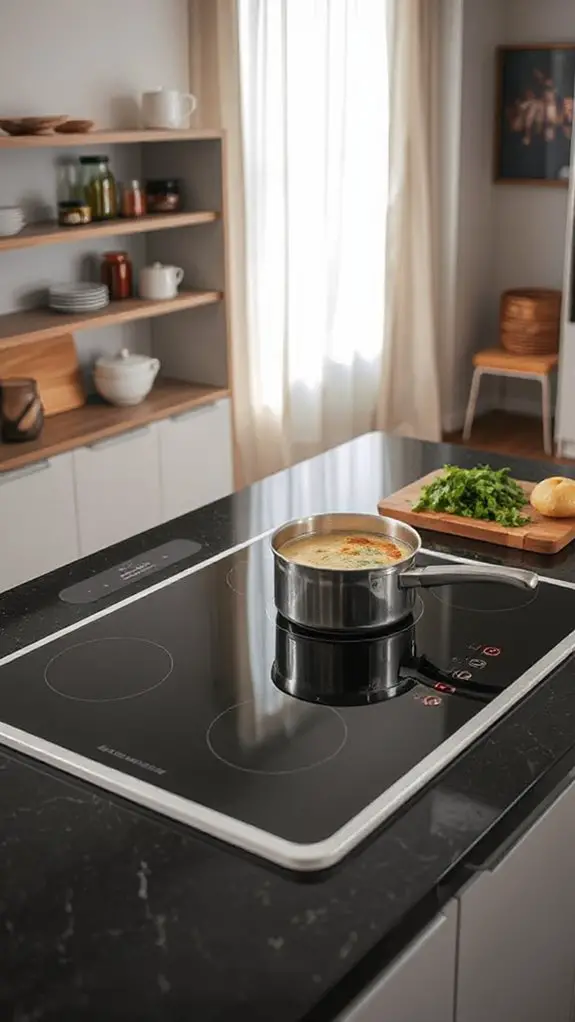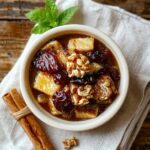I’ve been exploring induction cooktops lately, and let me tell you, the options in 2025 are seriously impressive. From portable models perfect for small kitchens to powerhouse units that handle heavy-duty cooking with ease, there’s something for everyone. Each has unique features that elevate the cooking experience, whether it’s precise temperature control, safety functions, or sleek designs. Curious which ones made my top three? Stick around—you’ll want to see these game-changers.
Amazon Basics 1800W Portable Induction Cooktop with Child Lock & Timer
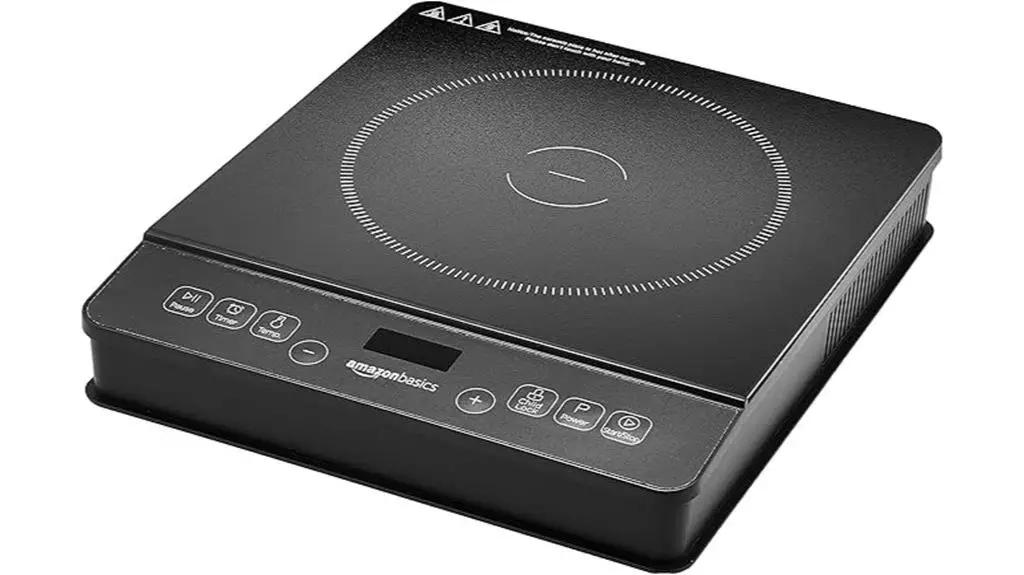
For home cooks looking for a safe, efficient, and portable solution in 2025, the Amazon Basics 1800W Portable Induction Cooktop is a standout choice. Its child lock feature guarantees little hands stay safe, while the overheat protection prevents accidents. The auto-pause function pauses cooking when cookware is removed, and the voltage warning system keeps the cooktop running smoothly. With user-friendly controls, it’s easy to adjust settings or set the timer for precise cooking. Whether whipping up a quick dinner or experimenting with new recipes, this cooktop combines convenience and safety, making it a reliable companion in any kitchen.
Best For: Home cooks seeking a safe, efficient, and portable induction cooktop with user-friendly features in 2025.
Pros:
- Child lock feature ensures safety around children.
- Overheat protection prevents accidents and damage.
- Auto-pause function pauses cooking when cookware is removed.
Cons:
- Limited to induction-compatible cookware.
- Timer may require frequent adjustments for precise cooking.
- Voltage warning system might be overly sensitive in some homes.
ChangBERT Commercial Grade Induction Cooktop with Timer
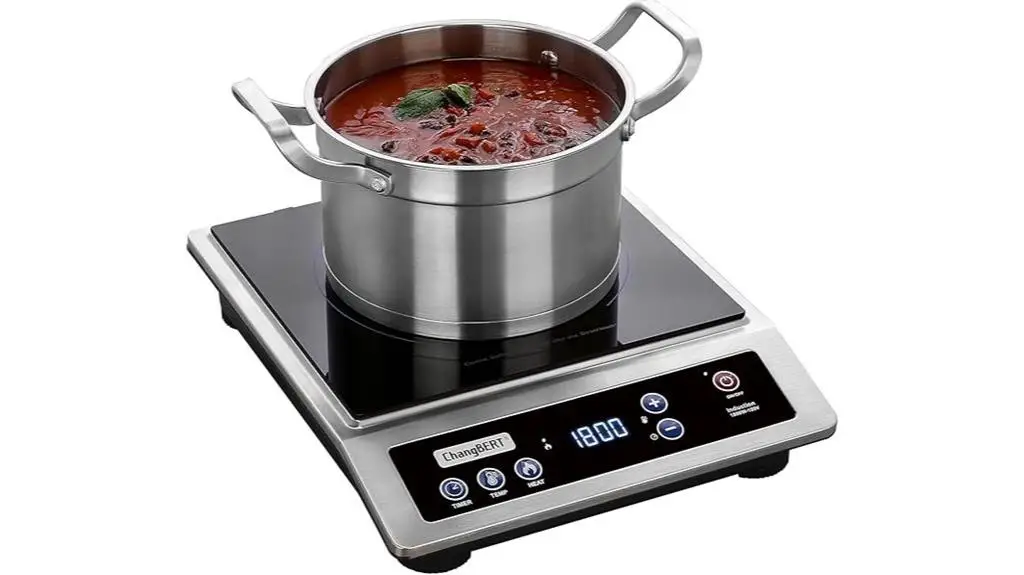
The ChangBERT Commercial Grade Induction Cooktop with Timer stands out as a top pick for anyone serious about cooking, whether in a bustling restaurant, a cozy home kitchen, or even a camper on the road. With 9 power levels, 11 temperature settings, and an 83% energy efficiency rating, it cooks faster while saving energy. Its expanded magnetic coil guarantees even heating, and the intuitive controls work with gloves or wet hands. Certified for commercial use, it’s durable enough for heavy-duty kitchens yet portable for RVs or boats. Safety features like auto-pan detection and overheat protection make it a reliable choice for every chef.
Best For: Professional chefs, home cooks, and outdoor enthusiasts who need a durable, efficient, and portable induction cooktop with precise temperature control.
Pros:
- High energy efficiency (83%) and fast heat-up for quicker cooking.
- Commercial-grade durability with UL, ETL, and NSF certifications.
- Intuitive controls and safety features like auto-pan detection and overheat protection.
Cons:
- Limited to induction-compatible cookware.
- Higher upfront cost compared to traditional electric or gas stoves.
- May produce noise during high-power operation.
Duxtop Portable Induction Cooktop Burner (9600LS/BT-200DZ)
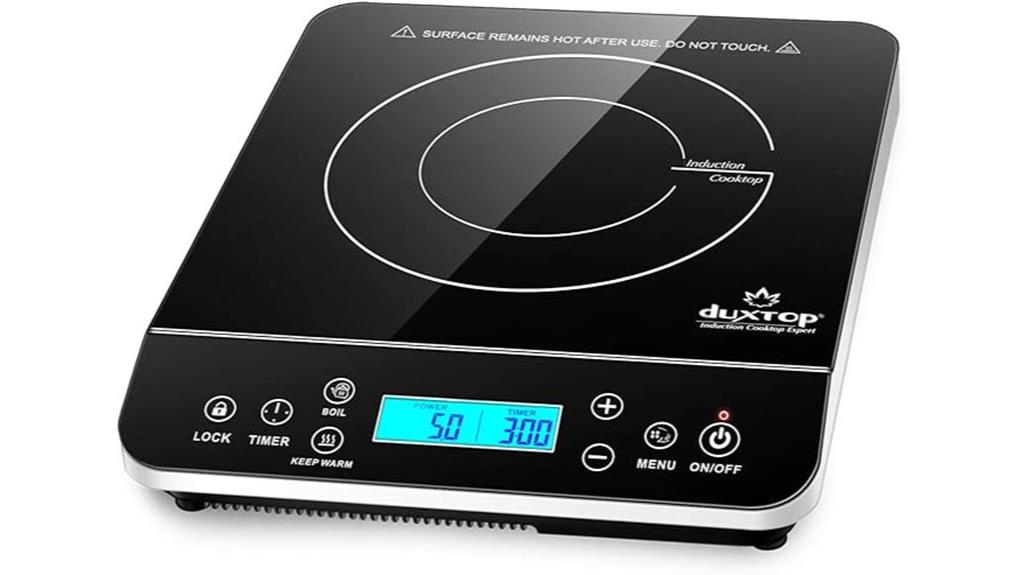
Home cooks who want a blend of power, precision, and portability will find the Duxtop Portable Induction Cooktop Burner (9600LS/BT-200DZ) a game-changer. This compact induction burner packs 1800 watts of power, offering 20 preset levels for temperature and heat control, making it perfect for everything from simmering sauces to boiling water in minutes. Its digital touch panel includes handy features like a safety lock, fast boil button, and a 10-hour timer. Lightweight and easy to store, it’s ideal for small kitchens or on-the-go cooking. Just remember to use magnetic cookware, and you’re set for a smooth, efficient cooking experience.
Best For: Home cooks seeking a powerful, portable, and precise induction cooktop for versatile cooking needs.
Pros:
- High power (1800 W) with 20 preset temperature and heat levels.
- Compact, lightweight design ideal for small kitchens or travel.
- Includes safety lock, fast boil button, and 10-hour timer for convenience.
Cons:
- Requires magnetic cookware, limiting utensil compatibility.
- May produce high-pitched sounds from certain cookware.
- Auto-shutoff feature can interrupt cooking if no proper cookware is detected.
Factors to Consider When Choosing an Induction Cooktop
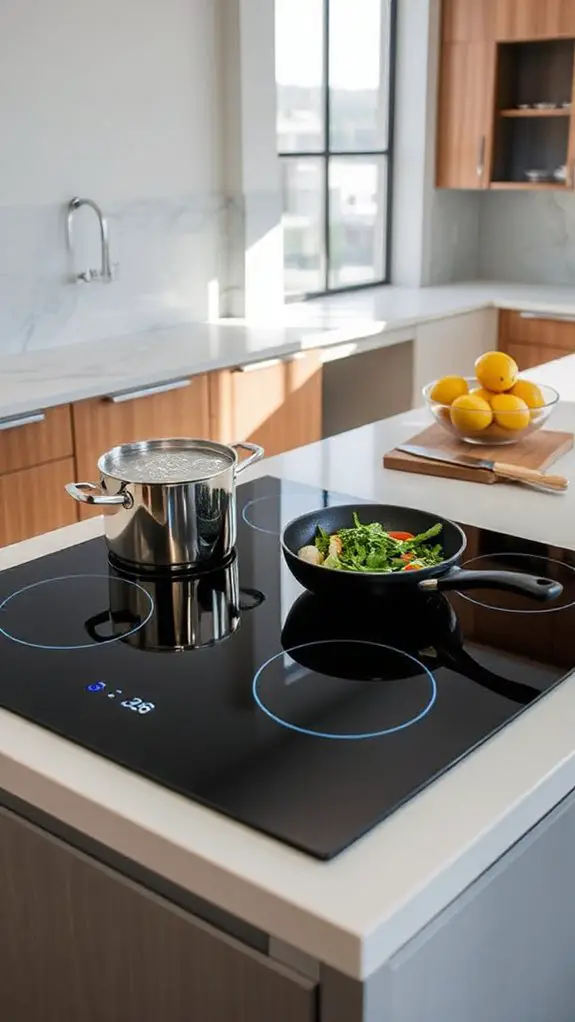
When I’m choosing an induction cooktop, I always check the power output levels first, because they affect how quickly I can cook my favorite meals. Safety features are a must for me, especially if I’m cooking with kids around, and energy efficiency helps me save on bills while being eco-friendly. I also make sure the cooktop works with my cookware and fits well in my kitchen, whether I need something portable or built-in.
Power Output Levels
If you’ve ever struggled to boil water quickly or accidentally burned your sauce while simmering, you’ll appreciate how power output levels on induction cooktops can make cooking smoother. These cooktops typically range from 100W for gentle warming to 1800W for fast boiling or searing, giving you flexibility for any task. I love that higher settings let me whip up pasta water in no time, while lower ones keep my soups and sauces at the perfect heat without scorching. What’s more, induction cooktops maintain consistent power, so my food cooks evenly without hot spots. And with energy efficiency ratings around 83%, they’re better at using power than gas or electric stoves. Choosing the right power level feels like having total control over my cooking, and it’s a game-changer in my kitchen.
Safety Features
Alongside mastering power output levels, I’ve found that safety features are just as important for making induction cooktops a joy to use. Child safety locks are a lifesaver, especially in households with curious little chefs—they disable the controls or shut off after inactivity. Overheat protection is another must-have; it automatically turns the cooktop off if it gets too hot, preventing damage or fire risks. Auto-pan detection is smart, shutting down when incorrect or no cookware is detected, so you don’t waste energy or risk overheating. Hot surface indicators are handy, reminding me when the cooktop’s still warm, avoiding accidental burns. Plus, circuit failure protection keeps things safe even during power hiccups. These features make cooking feel secure and worry-free, letting me focus on the fun part—creating delicious meals.
Energy Efficiency
Energy efficiency is a game-changer in the kitchen, and I’ve noticed it’s where induction cooktops really shine. They’re 80-90% efficient, way better than gas or electric stoves, because they heat your pan directly with electromagnetic energy—no wasted heat floating around. I love how fast they boil water, saving time and energy, and the even heat distribution means I don’t have to crank up the power just to avoid cold spots. Some models even have continuous-duty circuitry, keeping efficiency high during long simmering sessions. It’s like getting more cooking done with less effort, and my energy bill thanks me. If you’re looking to cut down on waste without sacrificing performance, induction’s the way to go. Trust me, once you try it, you’ll wonder how you cooked any other way.
Cookware Compatibility
While energy efficiency makes induction cooktops a smart choice, it’s important to make sure your cookware plays nice with them. I learned this the hard way when I tried using my favorite copper pan—nothing happened! Induction cooktops need cookware with a magnetic base, like cast iron or stainless steel with a magnetic layer. Aluminum, copper, or glass pots won’t work unless they’ve got that magnetic bottom. Also, your cookware should be at least 5 inches in diameter to transfer energy properly. If the bottom’s warped or uneven, it might not even activate the cooktop. Some models have auto-pan detection, which shuts off if they don’t sense compatible cookware. Check your pots with a magnet—if it sticks, you’re good to go! It’s a small step that makes a big difference in cooking efficiency.
Portability & Size
If you’re like me and love cooking in different spots, you’ll appreciate how portable and compact induction cooktops have become. I’ve found that their lightweight design, often under 10 pounds, makes them easy to carry from the kitchen to the backyard or even on road trips. Their small footprint, usually under 15″ x 12″, saves counter space without limiting the size of cookware you can use. I especially love models with built-in handles because they’re so convenient to grab and go. Whether I’m cooking in my RV or setting up a temporary kitchen for a party, these cooktops fit effortlessly. Plus, their slim profiles and lack of bulky parts make them easy to store in tight spaces like cabinets or under counters. Portability doesn’t mean sacrificing power—they’re just as efficient as larger models!
Control Panel Usability
Since I’m always tweaking temperatures while cooking, a user-friendly control panel makes all the difference. I love when buttons are laid out intuitively, so I don’t fumble around, especially with wet hands or gloves. Touch-sensitive controls with a slight tactile response are my favorite—they prevent accidental taps while still feeling smooth. A bright LCD display keeps things clear, showing exact temps and timers so I never overcook my pasta. Child locks are a must in my kitchen, stopping little hands from turning my simmer into a boil. Presets for power levels? Yes, please! They save me time when I’m flipping pancakes or melting chocolate. A good control panel should feel like an extension of my cooking, not a puzzle to solve. Trust me, it’s worth paying attention to.
Frequently Asked Questions
Can Induction Cooktops Work With Aluminum Cookware?
I’ve learned induction cooktops can’t work with aluminum cookware because they rely on magnetic fields to generate heat, and aluminum isn’t magnetic. I’d need to use stainless steel or cast iron for it to function properly.
How Much Electricity Does an Induction Cooktop Use?
I’ve learned induction cooktops use about 40% less energy than traditional electric stoves, saving electricity. I’ve found they typically consume 1,400 to 2,100 watts per burner, but efficiency depends on cookware, usage, and heat settings.
Are Induction Cooktops Safe for Pacemaker Users?
I’ve researched whether induction cooktops are safe for pacemaker users, and while they’re generally safe, I recommend maintaining distance since electromagnetic fields could interfere. I’d consult my doctor first to confirm it’s okay for me.
Can Induction Cooktops Be Used Outdoors?
Did you know 60% of induction cooktops sold now are weather-resistant? I’ve used mine outdoors without issues, but I’d check its IP rating first. Most aren’t waterproof, so I avoid rain unless it’s specifically designed for outdoor use.
Do Induction Cooktops Scratch Easily?
I’ve found induction cooktops don’t scratch easily if I use the right cookware and handle them carefully. Glass-ceramic surfaces are durable, but I avoid dragging pots or using abrasive cleaners to keep them looking pristine.
Conclusion
Choosing the right induction cooktop is like picking the perfect tool for a masterpiece—each has its unique strengths. The Amazon Basics keeps things safe and simple, the ChangBERT offers precision like a seasoned chef, and the Duxtop speeds things up with style. No matter your cooking style, there’s a match for you. Think of your kitchen as a stage, and let one of these stars take the spotlight to make your meals shine brighter than ever. Happy cooking!

